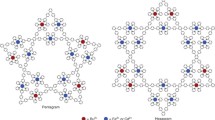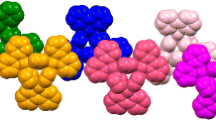Abstract
Individually prepared, equivalent amounts of 2,5-bis-(4-pyridyl)-1,3,4-oxadiazole (4-BPO) and benzenehexacarboxylic acid (mellitic acid, MA) when mixed, deposited long rods, whose X-ray structure showed a unique assembly of 40 membered planar modules composed from two alternating units each of MA and 4-BPO, rather than the anticipated helical profile. Several novel features of complexes of MA with organic molecules are seen here. In almost all cases the intermolecular hydrogen bonding between MA anions is so stable that the MA anions and the complementary cations lie in separate planes. This barrier is overcome in the present case. The basic module associates to form quartets by very simple hydrogen bonding of the carboxylic groups of MA. The quartet assembly is characterized by the rotation of the left hand pair compared to the right hand pair. The mode of the macromolecular assembly is clear, that is, they are layered in alternating planes. Space group: P21/c with a = 9.181(1) Å, b = 9.624(1) Å, c = 29.390(2) Å, and β = 94.626(4)°. The modules are embedded in an extensively hydrogen bonded MA network. The assembly profile of MA and 4-BPO is unique and should be a harbinger for the design of novel functional assemblies. The 40-membered module mimics the self-assemblies of peptides and can be important in the design of “Haptens” from simple molecules.
Index Abstract
Rod like crystals from water that are formed on mixing MA and 4-BPO are shown to consist of 4-molecule modules (MA–4-BPO–MA–4-BPO–) that contain a 40-membered ring, MA–BPO.









Similar content being viewed by others
References
Karle IL, Gilardi RD, Rao CHC, Muraleedharan KM, Ranganathan S (2003) J Chem Crystallogr 33:727. doi:10.1023/A:1026151222486
Karle IL, Rajesh YBRD, Ranganathan S (2005) J Chem Crystallogr 35:835. doi:10.1007/s10870-005-4554-9
Inabe T (2005) Mater Chem 15:1317. doi:10.1039/b413848a
Du M, Zhang ZH, Zhao XJ (2005) Cryst Growth Des 5:1247. doi:10.1021/cg0495680
Bentiss F, Lagrenee M (1999) J Heterocycl Chem 36:1029
Version SHELXTL 5.1: (1994) Madison, WI: Bruker, ASX, Inc.
Acknowledgments
SR and Rajesh are most grateful to the Department of Biotechnology, New Delhi, for generous financial assistance. Work performed at the Naval Research Laboratory was supported by the Office of Naval Research.
Author information
Authors and Affiliations
Corresponding author
Rights and permissions
About this article
Cite this article
Karle, I.L., Rajesh, Y.B.R.D. & Ranganathan, S. Crystal Engineering: A Unique Cyclic Assembly of a 40 Membered Module Composed from Two Alternating Units Each of Benzenehexacarboxylic Acid (Mellitic Acid, MA) and 2,5-Bis-(4-pyridyl)-1,3,4-oxadiazole (4-BPO): Assembly of Modules to Macromolecules by Intermolecular Hydrogen Bonding. J Chem Crystallogr 39, 201–208 (2009). https://doi.org/10.1007/s10870-008-9458-z
Received:
Accepted:
Published:
Issue Date:
DOI: https://doi.org/10.1007/s10870-008-9458-z




